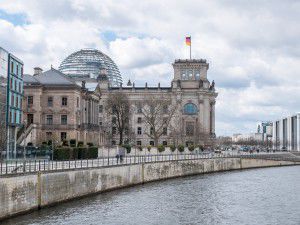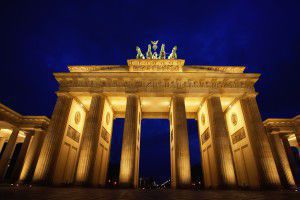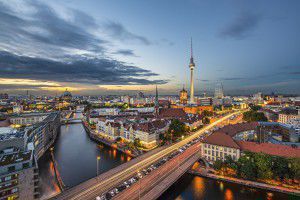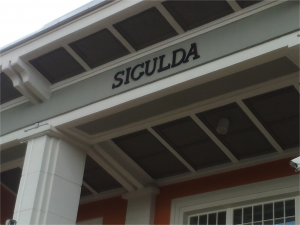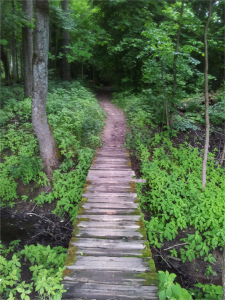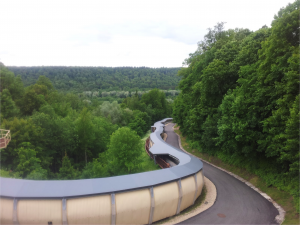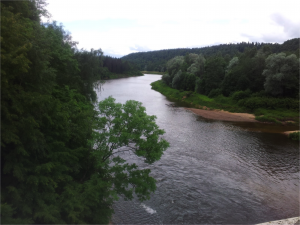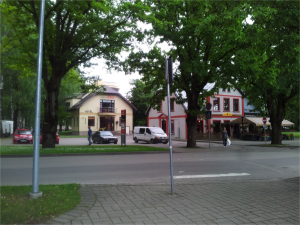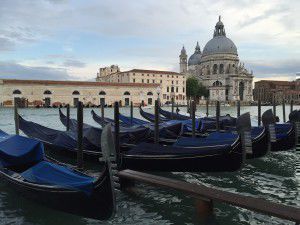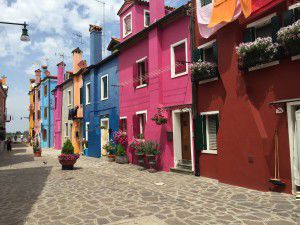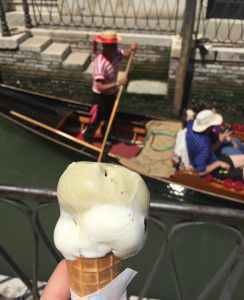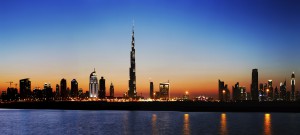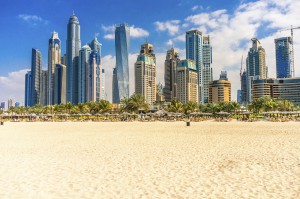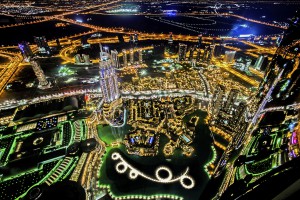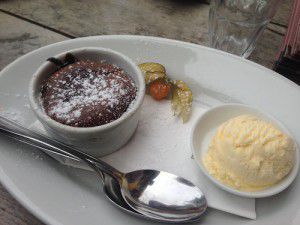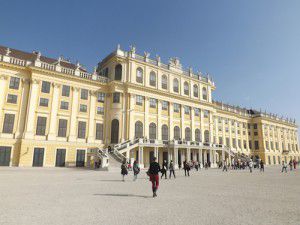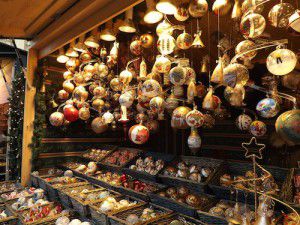A couple of days in Berlin
After volunteering in a hostel in Riga for six weeks, I decided to take the long way home via a series of overnight buses. With everyone raving about how beautiful a city Berlin is, I decided to make it my next stop on my journey home.
It is easy to see why people like it so much.
I stayed in a huge hostel in the Turmstrasse area and this seemed like a really good location to stop in. Just twenty minutes away was the Victory Column, or Siegessäule, which overlooks a large portion of the city. A little further was Potsdamer Platz; the centre is all commercial with cafes and restaurants as far as the eye can see and business reaching high up into the sky from a series of highly polished skyscrapers. But the surrounding area has a lot of history and culture to offer too. Personally the Topography Of Terror, Holocaust Memorial, Friedrichstrasse and Reichstag were the things that grabbed my attention the most. An early evening stroll in the local neighbourhood turned into a several hour stint that saw me leave my hostel, walk the length of Turmstrasse, past the Victory Column, down to the Holocaust Memorial and back on my first night.
There is no one ‘centre’ to Berlin, but it seems most tourists and locals end up at Alexanderplatz. Walking out of the station the first thing you see is the iconic tower that overlooks a pedestrianised area. Walking behind this and into a little blissful shade after a journey on an overheated train was very refreshing. There is a lot to see from here, and I personally headed over towards the galleries and sat under the pillars looking out over the river for a while.
The Zoological Gardens are definitely worth a visit, and if you like zoos and aquariums then it is a must. There’s a very cute windmill of sorts that sits along a section of Budapester Strasse which is worth stopping at to admire.
The Brandenburg Gate was such an impressive sight first hand, you can really understand the sense of power there and the thought of those streets being lined with people waiting to see a glimpse of their leader is both disturbing and breathtaking.
The area around Nordbahnhof was one of my favourite places, full of gardens, interesting architecture, and of course the Berlin Wall Memorial.
The main station, Hauptbahnhof, was also worth looking round, whether you like trains or not. There are so many levels, platforms, different types of train, shops, places to eat and drink, you could spend hours within this huge complex and not get bored.
Of course, one of the best things about Berlin, from my perspective at least, is the cake. Much like Greggs back home in the UK, there is a bäckerei (bakery) wherever you turn, and such a choice of sweet and savoury treats it can be a little overwhelming.
I spent the best part of two days in Berlin and I have to say, it isn’t enough. I could have happily stayed another week and I am still not sure if that would have been enough to have seen everything that I wanted to. A return trip is definitely in order!
Kelly
Planning a trip to Berlin? Remember to learn a little German before you leave with uTalk – or try our free Talk Now demo.
10 reasons to visit… Sigulda
If you haven’t heard of Sigulda, you probably aren’t in the minority. Described as the ‘Switzerland of Vidzeme’, Sigulda is popular with both locals and tourists alike. It is well worth a Google to see if it’s your thing.
Sigulda is a small town about 50 kilometres from Riga, Latvia. To get there from Riga takes about 45 minutes by car or around an hour by either train or bus. Sigulda sits on the edge of the Gaujas National Park, so there’s the opportunity to do both urban and natural sightseeing. The bus is 2,15 euros and the train 2,35; both are good, regular services.
The journey from Riga is very scenic, and if there’s any doubt that Latvia is the land of trees, this will quickly be removed the further you get into the countryside. Miles and miles of coppiced trees as well as trees left to succession, mostly birches in the deeper parts of the forest and silver birches lining the roads. In some places there are clumps of a species of bluebell and if it weren’t for the girth of the trees giving away their youth, you could be forgiven for mistaking some of the park as ancient woodland from England.
If you have two days to spare then you can see and do pretty much everything that Sigulda has to offer, but if you only have one day then that is ample time to have a good look around.
Sigulda is cute. It’s quaint. Cute little buildings, quaint little streets, homes that look like they are out of someone’s summer house dreams. Daisies are scattered throughout every area of grass, and there are wildflowers everywhere you look. A beautiful river, dramatic views where likely glacial erosion has shaped the landscape into an undulating wonder of a painter’s paradise. Which, coincidentally, is the name of one of the places suggested to visit.
Here’s a quick rundown of the ten best things to visit in Sigulda…
1. Bob Sleighing
You can follow the luge track from the Winter Olympic Games of 2014, and even if you’d rather just have a look at the site rather than take part, it’s an impressive view.
2. Sigulda Adventure Park Tarzan
If you’ve ever been to Go Ape, it’s pretty much the same deal. In other words, a lot of fun, in scenic surroundings.
3. Old Sigulda Castle
There are so many to choose from and if you’re pushed for time this one is (in my opinion) the prettiest. The original castle was built back in 1207 and the walls have been fortified multiple times owing to the tourist interest in the site.
4. Gutmanis Cave
If you like your caves this is a good alternative to Wookey Hole [in Somerset, England]! This is apparently both the largest and highest cave system in Latvia. It is thought to have begun forming 10,000 years ago at the end of the Ice Age.
5. Gauju River
You have two options here. You can either climb down a very lengthy but beautiful set of wooden stairs and walk over the bridge yourself (prepare yourself for the climb back. You will mostly likely have to stop a few times unless you have super-strength lungs or an incredible level of fitness). Or, if that sounds far too active for you, you can take the cable car that flies right over the top and gives you incredible views of the valley below. And as if that isn’t exciting enough, you can also bungee jump from the cable car. Obviously, this is optional.
6. Painters’ (Paradise) Hill
Stand on the top of this and you can look down on a valley at an almost never-ending tree line that is cut by the meandering Gauju River.
7. Town centre architecture
The town centre really is the most adorable little place to wander around aimlessly, lots of cute buildings with interesting facades. If you don’t feel like a ‘nature’ day you can happily amuse yourself here.
8. Aerodium
This is a giant wind tunnel that you can pretend you are sky-diving on, and is a lot of fun.
9. Sigulda Evangelic Lutheran Church
What list of things to visit would be complete without the obligatory church? This one is actually very pretty and definitely worth a look.
10. Mr. Biskvīts
Last but not least, there must be somewhere to eat and drink. This place is conveniently placed next to the train/bus station/central square and has an excellent range of hot and cold drinks as well as some very delicious food. Simply a must.
If you visit Riga, and this is highly recommended, a day trip to Sigulda during your stay is definitely worth your time. The tourism office is right next to the waiting room for the train/bus station and the staff will fall over themselves to help you. And if you want to plan ahead, check out the Sigulda Tourism site.
Kelly
10 reasons to visit… Venice
We’ve all seen the Italian city of Venice in the movies, but does it live up to its reputation as one of Europe’s most beautiful and historic cities? Amy says yes; here are her ten reasons to check out Venice for yourself.
1. Boats
I think this has to be a very obvious point, as of course Venice and boats go hand in hand. I was rather taken aback by the beauty of the boats, especially the private taxi boats, as they were all immaculate. If you’re landing when it’s still light, get a private taxi from the airport; it is magical and makes you feel like you’re in a James Bond movie cruising along the Grand Canal.
2. Get lost
Once again I think this is quite a popular theme, but honestly just wander about taking little side streets, because you never quite know what you are going to find, maybe a beautiful street, bridge, shop… or possibly a dead end. As long as you have a map with you when you’re ready to head back, you will be absolutely fine. Once you get to grips with the city it is relatively easy to get around and soon you’ll be wandering off to places without even needing any guidance.
3. Churches
The first world that comes to mind when thinking about the different churches in Venice is WOW. There are a vast number of churches across Venice and the ones we went into were simply stunning. We managed to see several, including St Mary of the Friars, where you can see the famous painting Titian’s Assumption of the Virgin, which caused a lot of commotion when it was first revealed. We also saw San Moisè and Santa Maria della Salute, as well as many more. Each church has a different history so you can never get bored of going into different ones.
4. Bridges
There are over 400 bridges in Venice and rather frequently you stumble upon one that’s just beautiful. They vary from concrete to iron; the concrete ones are traditional Venetian bridges, whereas the iron bridges are Austrian.
5. Islands
If you have the time I would definitely recommend hopping across to the different islands. Murano is the closest island, while Burano and Torcello are a little further away but still very easy to get to. We stopped off at Murano, which is famous for its glass, and we were fortunate enough to see the incredibly talented Glass Masters at work. Next was Burano, known for its lace and its colourful houses; this was so the fishermen could spot their house when they were out at sea. Finally we went to Torcello, which is tiny; there are only 15 homes on the island. Sights on Torcello include the Cattedral di Torcella, which was built in AD 1008, and the Santa Foscafe, which is very impressive to look at from the outside.
6. Beauty
I knew Venice would be beautiful, but what I wasn’t expecting was all of the detail that can be seen everywhere, in the churches, the bridges, and even engravings on some streets to represent different districts. Maybe I had rose tinted glasses on, but whenever I thought I had seen something beautiful I rounded a corner and there was something that topped it. It may sound like a cliché but Venice really does take your breath away.
7. Tour
This is an absolute must, because otherwise you can walk past something and have no idea you have passed a major piece of history. The tour means you really get to know Venice and learn about its history and culture, I can’t even begin to describe how much I learnt about the city and how relieved I was that we did a tour. Without it you could be standing in the square where Shakespeare based The Merchant of Venice and have no idea.
8. History
I can honestly say that I had no idea about the extensive history behind Venice, from the several plagues they suffered, to the different Dukes in power and of course Napoleon taking over the city. You definitely get a better feel for the city once you know more about its history, as well as starting to notice different things yourself when walking around, like the different types of bridges I mentioned earlier, or how the Austrians had to have their own cafés as they were not welcome anywhere else. I would read a little about the city before you go, just so you know a little about the Venetians’ background.
9. Food, Drink and Ice Cream
In Italy you expect great pizza and pasta; however Venice is very much based around seafood, although we also discovered an incredible steak restaurant called Vini Da Artur where we had the best steak we have ever eaten. Of course we had pasta and pizza too, but there is really something for everyone. For drinks, I recommend the Hilton Skyline Rooftop Bar for views of Venice and of course Harry’s bar, which originally opened in 1931 and was where the famous Bellini was invented. It is expensive, but just go for one Bellini to say you’ve experienced Harry’s bar, because the atmosphere in there is fantastic. Finally, ice cream was a must for us over the few days we were in Venice, due to it being very hot. There is a different ice cream shop on all of the busy streets, and they do not disappoint. Because you have to have at least one gelato while you’re in Venice, right?
10. St Mark’s Square
We’ve seen it in lots of films and pictures, but you can’t beat going and seeing it for yourself. Stepping into the square, the first thing you notice is how big it actually is. The main attraction – the church – is simply beautiful; the engravings all across the church and the different colours used are stunning. Going inside the church is a must, and you can pay €2 to go to the back of the church. Do it, you’ll see why. All across the square there are intricate engravings in the marble and different statues everywhere. I don’t want to spoil any surprises for anyone wanting to learn the history of the square, you have to go and experience it – and if you’re going with someone special, go at night too as it’s very romantic.
My only warning about Venice is that you do get harassed to buy a selfie stick or to feed the pigeons, so be prepared to say no!
And of course, don’t forget to download uTalk before you leave; even if you don’t have time to learn some Italian in advance, it’s a really useful app to have on your phone when you’re searching for the right word – we used it a lot!
Have you ever been to Venice? What did you think?
Amy
10 reasons to visit… Dubai
Dubai, in the United Arab Emirates, is known for being a global business hub and home to some of the world’s most incredible buildings. Amy visited the city over the Easter holiday and loved it; here are her top ten reasons to visit…
1. Burj Khalifa
The tallest building in the world – at least for another few months, anyway – is a sight you definitely won’t be able to miss. Designed to look like the Hymenocallis flower, it is beautiful from the outside and surprisingly not out of place or invasive to its surroundings. If you’re able to go up to the viewing platforms, I would recommend going at sunset because the view is spectacular, and to be able to view Dubai from such a height is really special. However, if you aren’t able to go up the Khalifa, you have to go to the fountains at the bottom, where you can see them dancing to different types of music.
2. The Dubai Mall
The Dubai Mall is the world’s largest shopping, leisure and entertainment destination. Anything and everything you can think of is there; it’s where the locals go to shop and even people from Abu Dhabi come at the weekend. They have a waterfall with bronze statues diving from the waterfall – this is where I found it rather peaceful and zoned out of the crowds behind me. It is definitely somewhere to go and have a look around, especially as it is attached to the Khalifa, but be prepared for the crowds.
3. The architecture
Dubai has grown considerably in the last 25 years. You can find pictures of Dubai in 1991, when there were only a handful of tall buildings, compared to now where it has become an architectural paradise. My personal favourite was the Cayan Tower, as it seemed to constantly glisten in the sun from every angle. I have also never seen a twisted building before.
4. Atlantis
This hotel on the man-made island Palm Jumeirah is simply incredible; it’s huge, and there are so many things that you can do. There is the aquarium, water park, swimming with dolphins and now swimming with sea lions. We had a lovely day here; firstly swimming with dolphins, and the look on my little brothers’ and sister’s face when they got to stroke the dolphins was magical. Then we went to the water park where they have awesome rides. It is definitely worth spending a day here.
5. The beaches
The beaches on the Palm felt a little too fake to me. However, the beaches off the Palm were beautiful. The sea was crystal clear, so you could see where you were walking, and rock-free so you didn’t have to worry about stubbing your toe. We got to see the sea when it was perfectly still, which was lovely for swimming in. Then we got to see it when the waves were huge; this was great fun to jump the waves. You felt safe the whole time, as there were lifeguards in kayaks out at sea as well as several on the beach.
6. The weather
We were in Dubai for eight days and the weather was glorious the whole time; if anything it became too hot on one day, when it reached 42°C. There aren’t many places where you can escape to at Easter for a week and be guaranteed good weather the whole time you are there, but Dubai is definitely a safe bet.
7. Sky Dive Dubai
I think it is on quite a lot of people’s bucket list to do a sky dive, and I finally gained the courage to sign up to do one. The experience is one that is tricky to put into words, as you going through several different stages. In the plane there are nerves, but they’re very good at keeping you talking so you don’t notice how high you are. Next, walking up to the door I felt complete terror and it finally sunk in that I was about to jump out of a plane!!! Then just pure adrenaline throughout the free fall; this was definitely my favourite stage. Once the parachute releases, there’s relief at first and then you get to enjoy Dubai from the sky, admiring the view from different angles. Once the landing is over, there is the ‘thank goodness I made it down safely’ feeling, followed by ‘I want to do it all over again’!
8. Hotel Al Qasr
We had a little disaster with our first hotel; however when we moved to our second hotel the Al Qasr, I have never seen anything like it. It’s an oasis in paradise. You have to get boats to different parts of the hotel, which is a great experience and a good way to see different parts of the hotel. There’s even a traditional souk, where you can go and practise your haggling skills.
9. The unexpected
Wherever you go in Dubai you never really know what you are going to get, which makes it all the more exciting. You never know if you are going to find something modern or something more traditional; around each corner lies something different. That is one of the things I love about Dubai, the architecture and landscape varies so dramatically. I can’t wait to go back and explore even more.
10. Desert Adventures
This is a great excursion to do; I admit it’s a little cheesy but it’s great fun, and definitely an experience you won’t forget. You get picked up in a big 4×4 and before long you have left the concrete jungle and are into the desert. You skid down sand dunes and attempt to get back up them; I have full respect for the drivers as I have no idea how we didn’t end up rolling down the dunes. Next you get to watch the sunset over the desert, which is stunning, followed by dinner in the desert at a makeshift fort. You are serenaded by belly dancers and can enjoy a camel ride.
Have you ever been to Dubai? What are you favourites bits about this diverse city?
Amy
10 reasons to visit Vienna
Today’s ’10 reasons’ guest post comes from Charlotte, who’s currently living and working in Vienna, Austria. If you’d like to read more from Charlotte, you can follow her blog or find her on Twitter.
So here are 10 reasons to visit Vienna… Do you have any to add?
1. Have you seen how pretty it is?
One of the first things you’ll notice, if you go to Vienna, is the architecture. You name an architectural style and there are probably buildings in Vienna based on it, in some shape or form. And even if you’re not a massive fan of the City Hall, or the Burgtheater, then there are plenty of places to enjoy more modern buildings and designs, like the huge Main Public Library or even sitting on the Enzis (some colourful outdoor furniture) in the inner courtyard of the MuseumsQuartier. My favourite building in Vienna is the Hundertwasserhaus, a definite must see – and it’s not like it costs anything to look at it!
2. You can catch an opera or go to a museum.
There’s certainly plenty to choose from in the opera department. The Vienna State Opera (Staatsoper) offers more than 350 performances per season – that’s ballet, opera, and different concerts. If you don’t mind standing, it’s also not too expensive, though you do have to queue for a while beforehand. However, this is one of those things I would recommend if you aren’t in a hurry and you have a little bit of extra cash. Where would be a better place to see an opera but this historical city in a country famous for its musicians? Plus, there are a lot of museums in Vienna. There’s the Natural History Museum, the Art History Museum, the Leopold Museum, the Jewish Museum, the Museum of Technology… There are, in fact, over 100 museums in this city. Some of them are old palaces – like Belvedere or Liechtenstein City Palace – and some of them might seem odd – like The Third Man Museum or the Funeral Museum – but they’re all interesting and there’s something here to suit everyone.
3. You can eat at the Naschmarkt.
I’m not going to lie, the Naschmarkt is one of my favourite places in Vienna, for one reason only – it sells food. It’s around 1.5km long and people there sell spices, fresh fruit and vegetables, cheese, seafood, meats, bread… You name it and they probably sell it there. Plus, there are a bunch of small restaurants where you can sit and eat anything from Chinese dumplings to baklava to traditional Viennese food like Palatschinken. Yum!
4. You can chill out on the Donauinsel.
The Danube runs through Vienna, as it does through many other European cities, but here they’ve got an island that runs along the middle of it and you can reach on the subway. Especially popular in the summer, you can sit and have a picnic, or read, or do what others are doing and rollerblade or bike around it. Plus, every year they hold the Donauinselfest, an outdoor music festival and Europe’s biggest open-air event. Considering that its main purpose is to protect Vienna from flooding, it has developed into one of the main areas of entertainment in the city and is a lovely place to waste away a day or three.
5. You can – and should – eat Sachertorte.
Sachertorte is to Vienna what the Victoria Sponge is to the UK – maybe people don’t eat it every day, but they’re certainly aware of its existence and will take the time to explain to you that you should try it as soon as possible. What it actually is, is a dense, delicious, chocolate cake with dark chocolate icing, held together by apricot jam (yes – the apricot jam might seem a little strange at first, but when you consider that in the Austrian dialect they actually have their own separate word for apricot, then you’ll understand that you’re going to come across it often and maybe in surprising places). The ultimate place to eat it, apparently, is at the Hotel Sacher, but you can buy Sachertorte at probably every café in the city. Make sure you get a slice if you’re in Vienna on the 5th December – that’s National Sachertorte Day.
6. Vienna has the oldest zoo in the world!
You may have already heard of Schönbrunn Palace, which is an imperial summer palace and worth a visit, particularly on a sunny day. Well, on the same grounds is the Tiergarten Schönbrunn (Schönbrunn Zoo), which, having been founded in 1752, claims to be the oldest zoo in the world. It is one of a few zoos to house Giant Pandas (including three that were born in the zoo) and currently houses over 700 species. It is also one of few attractions in Vienna that is open 365 days a year (most things close on Sundays) – so you can go whenever you feel like it.
7. You can visit St. Stephen’s Cathedral.
It can get a bit dull visiting churches and cathedrals all the time, especially in a country like Austria, which is teeming with them, but if you only choose to visit one, then choose this one. This is Vienna’s landmark and it is the most important religious building in the city, and if you don’t feel like just going in for a look around, there is always the opportunity to attend a concert here instead. Plus, it sits on Stephansplatz, basically the city centre, so it’s not like you’ll miss it.
8. It’s an easy task to go wherever you want.
So maybe I shouldn’t highlight ways to leave the city in a post about why you should go there, but considering Vienna’s – and Austria’s – position in Europe, this was bound to come up. The fact is, it’s really easy to go somewhere else and, in most cases, it’s quite cheap too. It’s an hour to Bratislava; you just hop over the border into Slovakia and it’s less than 20€ for a return ticket. It’s three hours to Budapest, the other capital of the Austro-Hungarian empire (and worth a visit if you’re interested in exploring that theme) and four hours to Munich, or Innsbruck, or Prague. You can get cheap tickets to all of these places too, provided that you book in advance or that you get hold of some kind of discount card (not difficult to do). So, you know, if there isn’t quite enough to keep you entertained in Vienna, you can always make a quick trip somewhere else.
9. You can visit the Prater.
The Prater is a huge public park in Vienna, but probably the most famous part of it is the Wurstelprater amusement park, which takes up one corner. This is the home to the Wiener Riesenrad (the Ferris wheel), along with plenty of other rides, but also restaurants, bars, a Madam Tussauds and at least one night club. You could spend a day and a night here, if you wanted, as there’s plenty to do and as it costs nothing to get in (you pay per attraction), you can just wander around the park and explore.
10. If you come in December, you can visit a Christmas Market or five.
Much like the thing with the apricots, the Austrians have a different name for Christmas Markets (Christkindlmarkt) to their German counterparts, but the principle is somewhat similar. Late October to early November, you’ll see the stands being built and lights being strung – and then from the first weekend of November, the markets begin to open, selling drinks and food and decorations and gifts. I’m not sure exactly how many Christmas Markets there are, but essentially they’re everywhere, so you’ll just stumble across them as you wander the city. Like Germany, Glühwein (mulled wine) is a big thing here, but so is punch – and if you’re not so into the wine, you can buy Glühbier (mulled beer) in certain places. If you don’t drink at all, then there are plenty of places that offer non-alcoholic punch, in a variety of places. So, get a drink, buy yourself some food and soak up that festive atmosphere!
Charlotte
xuexisprachen.wordpress.com
@luna_moonsilver
(Photo credit: Charlotte Donnelly)
Do you have a favourite place that everyone should know about? Let us know!
